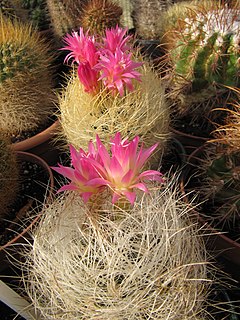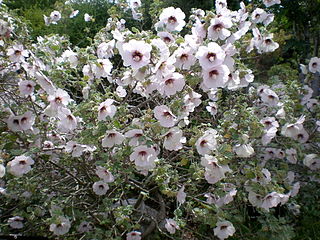
Fuchsia is a genus of flowering plants that consists mostly of shrubs or small trees. The first to be scientifically described, Fuchsia triphylla, was discovered on the Caribbean island of Hispaniola about 1696–1697 by the French Minim monk and botanist, Charles Plumier, during his third expedition to the Greater Antilles. He named the new genus after German botanist Leonhart Fuchs (1501–1566).

Chard or Swiss chard is a green leafy vegetable. In the cultivars of the Flavescens Group, the leaf stalks are large and often prepared separately from the leaf blade; the Cicla Group is the leafy spinach beet. The leaf blade can be green or reddish in color; the leaf stalks are usually white, or a colorful yellow or red.

Cleistocactus is a genus of flowering plants in the cactus family Cactaceae, native to mountainous areas - to 3,000 m (9,843 ft) - of South America. The name comes from the Greek kleistos meaning closed because the flowers hardly open.

Matucana is a genus of cacti, containing approximately 20 species of mostly globular plants. The genus is only known from Peru, mostly along the Marañón River.

Eriosyce is a genus of cacti native to Chile.

Allium carinatum, the keeled garlic or witch's garlic, is a bulbous perennial flowering plant in the family Amaryllidaceae. It is widespread across central and southern Europe, with some populations in Asiatic Turkey. It is cultivated in many places as an ornamental and also for its potently aromatic bulbs used as a food flavoring.

Thelocactus bicolor, the glory of Texas, is a species of flowering plant in the cactus family, widely distributed in the northern Chihuahuan Desert of the USA (Texas) and Mexico. Plants are usually solitary, but may form clumps. Growing to 50 cm (20 in) tall, it is a perennial with spiny, ribbed, succulent stems. Large daisy-like flowers, up to 8 cm (3.1 in) in diameter, are borne in summer. The petals are purplish-pink, fading to white. The inner petal tips form a circle of red surrounding a prominent yellow boss.

Copiapoa hypogaea, the underground copiapoa, is a species of flowering plant in the genus Copiapoa in the cactus family (Cactaceae), native to northern Chile. It has gained the Royal Horticultural Society's Award of Garden Merit.

Eriosyce senilis, called old-man cactus along with a number of similar species, is a species of cactus in the genus Eriosyce, native to Chile. It has gained the Royal Horticultural Society's Award of Garden Merit.

Matucana intertexta is a species of cactus in the genus Matucana, native to Peru. It has gained the Royal Horticultural Society's Award of Garden Merit.

Rebutia mentosa, the crown cactus, is a species of cactus in the genus Rebutia, native to Bolivia. It has gained the Royal Horticultural Society's Award of Garden Merit.

Rebutia neocumingii, the Cuming crown cactus, is a species of cactus in the genus Rebutia, native to Bolivia and Peru. It has gained the Royal Horticultural Society's Award of Garden Merit.

Rebutia pulvinosa is a species of cactus in the genus Rebutia, native to Bolivia. Two of its subspecies, Rebutia pulvinosa subsp. albiflora and Rebutia pulvinosa subsp. perplexa, have gained the Royal Horticultural Society's Award of Garden Merit.

Rebutia steinbachii, called Steinbach's crown cactus, is a species of cactus in the genus Rebutia, native to Bolivia. It has gained the Royal Horticultural Society's Award of Garden Merit.

Genista sagittalis, called the arrow-jointed broom and winged broom, is a species of flowering plant in the genus Genista, native to central and southern Europe, Ukraine, and Anatolia. Its subspecies Genista sagittalis subsp. delphinensis, called rock broom, has gained the Royal Horticultural Society's Award of Garden Merit.

Primula chionantha, the snow-white primrose, is a species of flowering plant in the family Primulaceae, native to Tibet, Sichuan and Yunnan in China. It has gained the Royal Horticultural Society's Award of Garden Merit.

Echinopsis arachnacantha is a species of cactus in the genus Echinopsis, native to Bolivia. It has gained the Royal Horticultural Society's Award of Garden Merit.

Androsace laggeri, the pink rock jasmine, is a species of flowering plant in the family Primulaceae, native to the central Pyrenees. As Androsace carnea subsp. laggeri it has gained the Royal Horticultural Society's Award of Garden Merit.

Pfeiffera monacantha, the one‑spined wickerware cactus, is a species of epiphytic cactus, native to Bolivia and northwest Argentina. As its synonym Rhipsalis monacantha it has gained the Royal Horticultural Society's Award of Garden Merit.

Malva subovata, the tree mallow, is a species of flowering plant in the family Malvaceae, native to the shores of the western and central Mediterranean. As its synonym Lavatera maritima it has gained the Royal Horticultural Society's Award of Garden Merit.




















